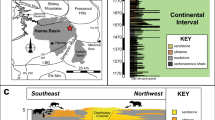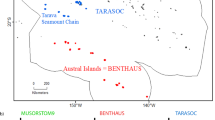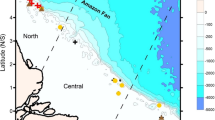Abstract
The geographical origin of modern humans is the subject of ongoing scientific debate. The ‘multiregional evolution’ hypothesis argues that modern humans evolved semi-independently in Europe, Asia and Africa between 100,000 and 40,000 years ago1, whereas the ‘out of Africa’ hypothesis contends that modern humans evolved in Africa between 200 and 100 kyr ago, migrating to Eurasia at some later time2. Direct palaeontological, archaeological and biological evidence is necessary to resolve this debate. Here we report the discovery of early Middle Stone Age artefacts in an emerged reef terrace on the Red Sea coast of Eritrea, which we date to the last interglacial (about 125 kyr ago) using U–Th mass spectrometry techniques on fossil corals. The geological setting of these artefacts shows that early humans occupied coastal areas and exploited near-shore marine food resources in East Africa by this time. Together with similar, tentatively dated discoveries from South Africa3 this is the earliest well-dated evidence for human adaptation to a coastal marine environment, heralding an expansion in the range and complexity of human behaviour from one end of Africa to the other. This new, widespread adaptive strategy may, in part, signal the onset of modern human behaviour, which supports an African origin for modern humans by 125 kyr ago.
This is a preview of subscription content, access via your institution
Access options
Subscribe to this journal
Receive 51 print issues and online access
$199.00 per year
only $3.90 per issue
Buy this article
- Purchase on Springer Link
- Instant access to full article PDF
Prices may be subject to local taxes which are calculated during checkout


Similar content being viewed by others
References
Thorne,A. & Wolpoff,M. The multiregional evolution of humans. Sci. Am. April, 28–33 (1992).
Stringer,C. B. The emergence of modern humans. Sci. Am. December, 98–104 (1990).
Deacon,H. J. in The Human Revolution: Behavioural and biological perspectives on the origins of modern humans (eds Mellars, P. & Stringer, C.) 547– 564 (Princeton Univ. Press, 1989).
Faure,H. & Roubet,C. Découverte d’un biface Acheuléen dans les calcaires marins du golfe Pléistocène de l’Afar (Mer Rouge, Éthiopie). C. R. Acad. Sci. Paris 267, 18–21 ( 1968).
Montenat,C. Un aperçu des industries préhistoriques du golfe de Suez et du littoral Égyptien de la Mer Rouge. Bull. Inst. Fran. d’Archéol. Orien. 86, 239– 255 (1986).
Plaziat,J.-C. et al. in Sedimentation and Tectonics in Rift Basins: Red Sea-Gulf of Aden (eds Purser, B. H. & Bosence, D. W.J.) 537– 573 (Chapman & Hall, London, 1998).
Clark,J. D. The Middle Stone Age of East Africa and the beginnings of regional identity. J. World Prehist. 2, 237– 305 (1988).
Walter,R. C., Buffler,R. T., Berhe,S., Vondra,C. & Yemane,T. in Lithospheric Structure, Evolution And Sedimentation In Continental Rifts (Abstracts) (eds Jacob, A. W. B., Delvaux, D. & Khan, M. A.) (Dublin Institute for Advanced Studies, Dublin, Ireland, 1997).
Phillipson,D. W. African Archaeology (Cambridge Univ. Press, 1993).
Van Peer,P. The Nile corridor and the out-of-Africa model. Curr. Anthropol. 39, 115–140 ( 1998).
Gvirtzman,G., Kronfeld,J. & Buchbinder, B. Dated coral reefs of the southern Sinai (Red Sea) and their implication to late Quaternary sea levels. Mar. Geol. 108, 29–37 (1992).
El-Asmar,H. M. Quaternary isotope stratigraphy and paleoclimate of coral reef terraces, Gulf of Aqaba, south Sinai, Egypt. Quat. Sci. Rev. 16, 911–924 (1997).
Hoang,C. T. & Taviani,M. Stratigraphic and tectonic implications of uranium-series dated coral reefs from uplifted Red Sea islands. Quat. Res. 35, 264–273 ( 1991).
Hoang,C. T., Dalongeville,R. & Sanlaville, P. Stratigraphy, tectonics and paleoclimatic implications of uranium-series dated coral reefs from the Sudanese coast of the Red Sea. Quat. Int. 31, 47–51 (1996).
Conforto,L., Delitala,M. C. & Taddeucci, A. Datazioni col 230Th di alcune formazioni coralligene delle Isole Dahlak (Mar Rosso). Soc. It. Min. Pet. 32, 153–158 ( 1976).
Hoang,C. T., Lalou,C. & Faure,H. Les récifs soulevés a l’ouest du golfe d’Aden (T. F. A. I.) et les hauts niveaux de coraux de la dépression de l’Afar (Éthiopie), géochronologie et paléoclimats interglaciaires. Col. Int. CNRS 219, 103– 116 (1974).
Faure,H., Hoang,C. T. & Lalou,C. Datations 230Th/234U des calcaires coralliens et mouvements verticaux a Djibouti. Bull. Soc. Géol. Fr. 22, 959–962 (1980).
Taviani,M. in Sedimentation and Tectonics in Rift Basins: Red Sea-Gulf of Aden (eds Purser, B. H. & Bosence, D. W. J.) 574–582 (Chapman & Hall, London, 1998).
Edwards,R. L., Chen,J. H. & Wasserburg, G. J. 238U-234U-232Th systematics and the precise measurement of time over the past 500,000 years. Earth Planet. Sci. Lett. 81, 175– 192 (1986/87).
Cheng,H. et al. The half-lives of uranium-234 and thorium-230 (in the press).
Chen,J. H., Curran,H. A., White,B. & Wasserburg,G. J. Precise chronology of the last interglacial period: U-234-Th-230 data from fossil coral reefs in the Bahamas. Geol. Soc. Am. Bull. 103, 82–97 (1991).
Stirling,C. H., Esat,T. M., Lambeck,K. & McCulloch,M. T. Timing and duration of the Last Interglacial: evidence for a restricted interval of widespread coral reef growth. Earth Planet. Sci. Lett. 160, 745–762 (1998).
Gvirtzman,G., Buchbinder,B., Sneh,A., Nir,Y. & Friedman,G. Morphology of the Red Sea fringing reefs: a result of the erosional pattern of the last-glacial low-stand sea level and the following Holocene recolonization. Mém. Bur. Rech. Géol. Min. 89, 480–491 (1977).
Klein,R. G. in The Human Revolution: Behavioural And Biological Perspectives On The Origins Of Modern Humans (eds Mellars, P. & Stringer, C.) 529– 546 (Princeton Univ. Press, New Jersey, 1989).
Brink,J. & Deacon,H. A study of a last interglacial shell midden and bone accumulation at Herold's Bay, Cape Province, South Africa. Paleoecol. Afr. 15, 31– 39 (1982).
Leney,M. The road out of Africa. Discov. Archaeol. 1, 18 (1999).
Freytet,R., Baltzer,F. & Conchon, O. A Quaternary piedmont on an active margin: the Egyptian coast of the NW Red Sea. Z. Geomorph. N. F. 37, 215–236 (1993).
Horowitz,A. Continuous pollen diagrams for the last 3.5 m.y. from Israel: vegetation, climate and correlation with the oxygen isotope record. Paleogeogr. Paleoclimatol. Paleoecol. 72, 63–78 (1989).
Grûn,R. & Stringer,C. B. Electron spin resonance dating and the evolution of modern humans. Archaeometry 33 , 153–199 (1991).
Leakey,L. The Stone Age Cultures of Kenya Colony (Cambridge Univ. Press, 1931).
Acknowledgements
Permission to conduct field work was granted by the Department of Mines of the Ministry of Mines, Energy and Water Resources of Eritrea. We are grateful to A. Kibreab, T. Keleta, A. Mesfin and M. Abraha, G. Ogubazghi and B. Woldehaimanot, and the staff of the National Museum of Eritrea for their support. Financial support was provided by grants from Anadarko Petroleum Company, the National Science Foundation, the Institute of Human Origins, the Royal Ontario Museum and the University of Toronto. Donations by TOTAL Eritrea are gratefully acknowledged. We thank M. Kusmu, L. Le Vert, the French Ministry of Foreign Affairs, the Canadian Consulate and the US Embassy in Asmara. We also thank M. Abdelsalam, T. Andemariam, J. Aronson, B. Collins, C. Cermignani, M. Chazan, S. Churchill, D. Doumenc, E. Goodman, M. Gorton, D. Guinot, Y. Lam, A. Martyn, N. Mohammed, N.-H. Nguyen, J. Pandolfi, K. Reed, H. Shoshani, G. Smithwalter, R. Stern, M. Tesfaye, J. Trondle, M. de Saint Laurent, F. Taylor, G. Watson, C. Vondra and T. Yemane for assistance and/or discussions. Bifaces were first observed on the coast near Abdur by C. Hillman and reported to RCW. in 1995.
Author information
Authors and Affiliations
Corresponding author
Rights and permissions
About this article
Cite this article
Walter, R., Buffler, R., Bruggemann, J. et al. Early human occupation of the Red Sea coast of Eritrea during the last interglacial. Nature 405, 65–69 (2000). https://doi.org/10.1038/35011048
Received:
Accepted:
Issue Date:
DOI: https://doi.org/10.1038/35011048
This article is cited by
-
Transformative Impacts of Sea-Level Rise, Storm Surge, and Wetland Migration on Intertidal Native Shell-Bearing Sites in Florida’s Largest Open-Water Estuary, Tampa Bay, Florida, USA
Estuaries and Coasts (2024)
-
Aquaculture in the Ancient World: Ecosystem Engineering, Domesticated Landscapes, and the First Blue Revolution
Journal of Archaeological Research (2023)
-
Climatic windows for human migration out of Africa in the past 300,000 years
Nature Communications (2021)
-
Explanations of variability in Middle Stone Age stone tool assemblage composition and raw material use in Eastern Africa
Archaeological and Anthropological Sciences (2021)
Comments
By submitting a comment you agree to abide by our Terms and Community Guidelines. If you find something abusive or that does not comply with our terms or guidelines please flag it as inappropriate.



